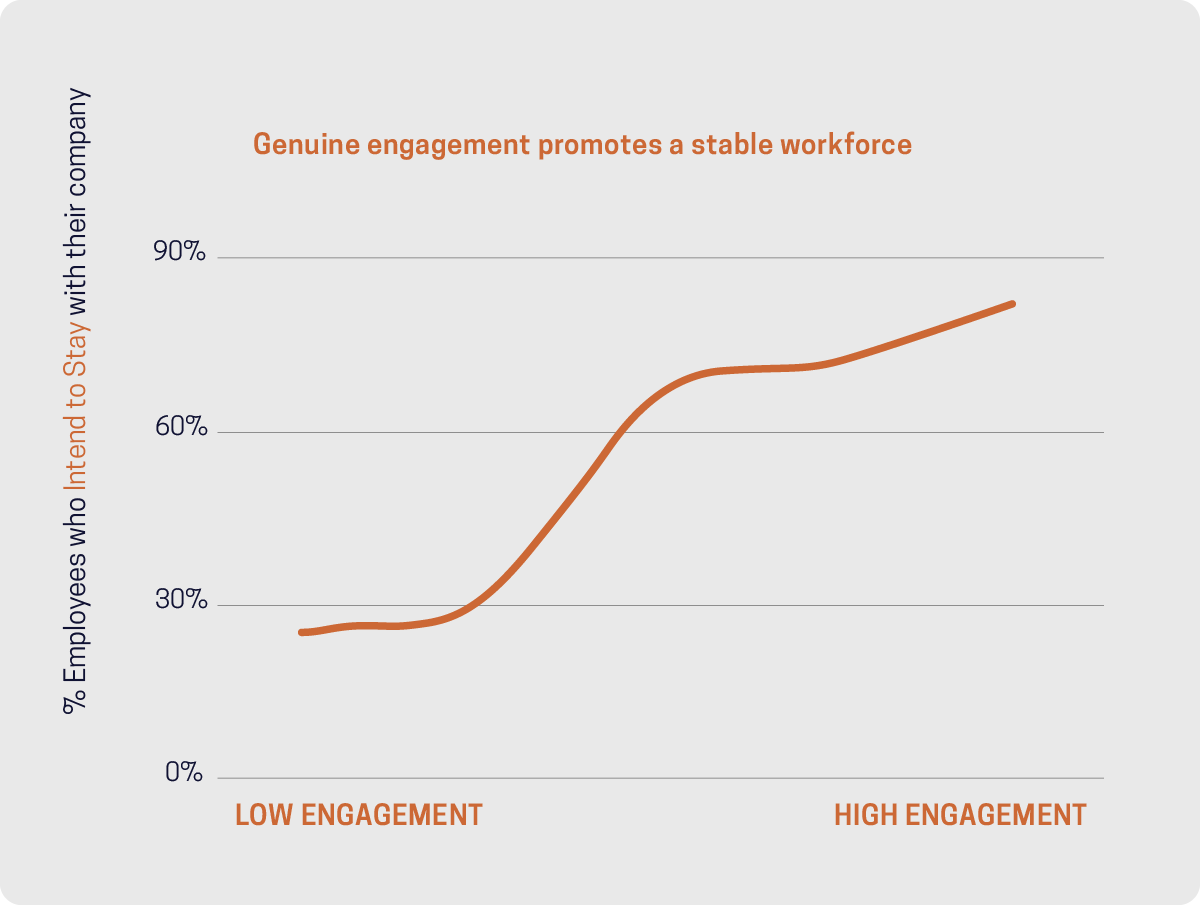Most companies fail to accurately measure employee engagement – wasting a critical opportunity to understand an element of the employee experience that can be more important than money for retaining top talent.
As companies position themselves to bounce back from the disruptions of the last year, employee engagement will be more important than ever. A recent Microsoft study revealed that employees feel less engaged, more exhausted, and more disconnected than they did a year ago. Re-energizing employees will be key to any company’s efforts to take advantage of the momentum of the current environment and avoid being left behind. To successfully boost engagement, companies must first understand the current state of their employees. Unfortunately, that is often easier said than done.
It’s a tale many Human Resources leaders are sadly familiar with: you try measuring employee engagement with the best of intentions, only to find that the data aren’t all that useful to the bottom-line numbers of your business. Sometimes the data don’t even seem to tell a clear story of what’s really affecting your employees. One reason for this common frustration is that companies often aren't actually measuring true employee engagement at all. So, what can engagement tell us when we measure it correctly? And why do so many companies struggle to get it right?
Measuring engagement correctly matters for company success.
Genuine employee engagement is a necessary component to an adaptable and resilient workforce. Because truly engaged employees are both energized by and invested in their work, they are intrinsically motivated to accomplish their jobs even in the face of organizational challenges1. In other words, engaged employees successfully adapt by “reflecting on what is necessary to create change so that their organizations can be increasingly competitive and effective2.”

Figure 1. Employees with high active engagement, as measured using McChrystal Group’s engagement survey, are significantly less likely to leave the organization. (Data provided from McChrystal Group’s engagement survey validation research, 2019.)
How do these engagement behaviors contribute to a resilient workforce? Employees who push to accomplish their jobs despite organizational challenges and change make the company as a whole less vulnerable to potentially crippling disruptions. These genuinely engaged employees also promote organizational stability in the face of hardship by being more likely to remain with the company. McChrystal Group’s research using our assessment of true employee engagement shows that engagement, when measured correctly, is actually more important than pay for predicting employees’ intentions to leave their jobs. Using genuine engagement metrics to mitigate turnover helps companies save on the real financial cost of hiring and training replacements, but it also preserves stable organizational knowledge, task ownership, and employee relationships.
Engaged or merely satisfied?
While many factors contribute to the utility (or lack thereof) of employee feedback data, one of the most pervasive issues is that companies only think they’re measuring employee engagement. Despite the demonstrated importance of an engaged workforce for company success, thousands of companies spend their valuable resources year after year unknowingly measuring employee satisfaction instead of engagement. What’s wrong with employee satisfaction? While employee satisfaction levels are useful to know, measuring satisfaction alone is insufficient to create the kinds of robust employee outcomes that will help your business thrive.
Employee satisfaction is fundamentally a passive concept that measures satiation rather than active enthusiasm. If you ask employees how they feel about their company, work environment, recognition, manager, coworkers, etc., you’re ultimately asking them to describe the favorability of their work conditions. While employees having a basic level of satisfaction with their work conditions is often a necessary precursor for engagement, assessing just these descriptive satisfaction levels falls far short of measuring the energetic passion that marks true employee engagement.
T. J. Erickson, Professor of Organizational Behavior at the London Business School, succinctly summarizes the fundamental difference between satisfaction and engagement:
Engagement is above and beyond simple satisfaction with the employment arrangement or basic loyalty to the employer – characteristics that most companies have measured for many years. Engagement, in contrast, is about passion and commitment – the willingness to invest oneself and expend one’s discretionary effort to help the employer succeed3.
Thus, in order to properly measure engagement, rather than simple satisfaction, companies must tap into what energizes and activates employee passion and commitment.
So, what is engagement then?
One of the most widely academically accepted models of employee engagement comes from leading organizational psychology researchers Wilmar Schaufeli and Arnold Bakker, who describe engagement as having three key components4,5:
- Dedication: Enthusiasm and pride toward work
- Vigor: Investment in work and persistence when challenges arise
- Absorption: Feelings of being engrossed in work
Measuring these more abstract, energetic feelings of genuine employee engagement is undeniably more challenging than measuring the straightforward satisfaction that often passes for engagement in many employee feedback surveys.
What can you do?
So, what can companies do to make sure they’re measuring engagement correctly? Company leaders should take a hard look at the engagement survey tool they’re currently using. Does the survey only ask employees how they feel about various aspects of their work environment? Or does it also assess employees’ feelings of energy, enthusiasm, and passion for their work? For example, McChrystal’s unique employee engagement survey asks questions that explore whether employees are challenged by their work, whether their work makes them feel upbeat, and whether they derive meaning from their job tasks.
To be clear, companies should not eliminate questions of satisfaction altogether. While these questions are not sufficient to capture true engagement, they may illuminate important levers that the company can use to increase employee engagement. In a future article, we will go into detail about specific elements of satisfaction and other important precursors necessary for companies to effectively lay the groundwork for true employee engagement.
Citations:
[1] Kahn, W. A. (1992). To be fully there: Psychological presence at work. Human Relations, 45, 321–349.
[2] Macey, W., & Schneider, B. (2008). The meaning of employee engagement. Industrial and Organizational Psychology, 1, 3-30.
[3] Erickson, T. J. (2005). Testimony submitted before the U.S. Senate Committee on Health, Education, Labor and Pensions, May 26.
[4] Schaufeli, W., & Bakker, A. (2004). Job demands, job resources, and their relationship with burnout and engagement: A multi-sample study. Journal of Organizational Behavior, 25, 293-315.
[5] Gabriel, A. S., & Bennett, A. A. (2015). Getting engaged: Top tips for an engaged workforce. Society for Industrial and Organizational Psychology White Paper Series.




